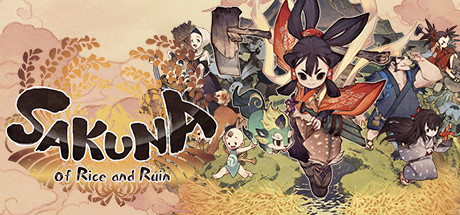Sakuna: Of Rice and Ruin is a combination of ActRaiser and Okami while retaining a great degree of originality and is one of the most satisfying games I’ve played in many months.
Type: Single-player
Genre: Spectacle Fighter,
Brawler, Farming
Developer: Edelweiss
Publisher: XSEED Games,
Marvelous USA
Release date: 10 Nov, 2020


Intro
Sakuna: Of Rice and Ruin (hereafter Sakuna) is yet another spiritual successor to ActRaiser, a game divided between two genres: an action platformer and a god game (see SolSeraph (you can find my review on it) for a different take). While ActRaiser was an extremely simple game in both of its components, Sakuna takes the idea many steps further by providing a 2D spectacle fighter and a fully fleshed-out farming game that dictates your character progression. It also has an interesting crafting system that focuses on variety and situationality rather than “by the numbers” upgrades.
The game is developed by Edelweiss, whose previous game, Astebreed, I also found surprisingly good. Sakuna is on a whole other level, however.
The game is quite long, having taken me nearly 40 hours to beat (contrast it with ActRaiser that was maybe 3 hours, and SolSeraph which was 8). Surprisingly, though, I’ve thoroughly enjoyed 90% of my time with it – something which is extremely rare for me. I dislike bloated games (Assassin’s Creed, Witcher 3, Shadow of War, and the list could go on – even Okami I found needlessly long), yet Sakuna’s length never felt unnecessarily padded.
Honestly, I don’t have much to critique about the game. Most of its elements are well developed and satisfying, although the combat seems to have a bit of an imbalance (in the player’s favor) at times, and the farming system can be a bit opaque – which will surely be resolved once the game is out and players can share ideas on the forums.
The most surprising aspect of the game, perhaps, was the writing and story – it’s actually good. It wasn’t just a vehicle to keep you, as the player, moving forward, but was moved by character with motivations of their own and great character development.
I’ll now go over the most important aspects of the game (in my experience, anyway). I’ll start with presentation, followed by a general overview of the two sides of gameplay, then a bit about the writing, and finally some particular gameplay concepts.
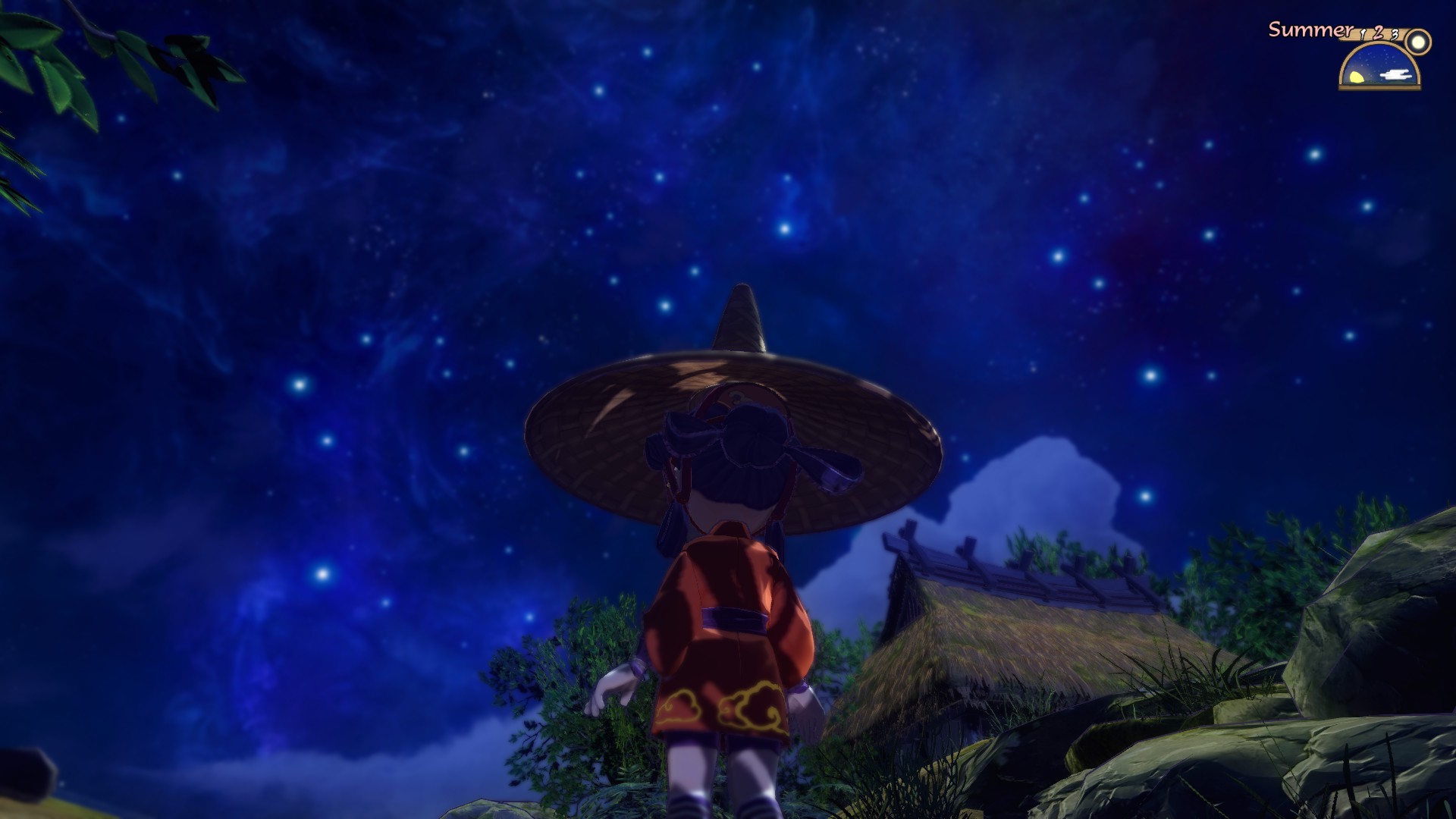
Presentation
I’ll be brief here. The game looks and sounds great. The visuals look like shiny 3D anime, which is fine, though I would have liked to see some more stylized, Okami-like, style. The music is also something that could come right out of Naruto’s fighting music. Some of it is cheesy, but it’s very well executed, adds great atmosphere, and some of the boss tracks were awesome – although they were in the background a bit too much. Very Japanese, though, in a good way.
The voice acting will probably be a bit divisive. The game offers both English and Japanese audio. I quickly switched to Japanese, since the main character sounds like the most annoying cartoon for 3 year olds. It isn’t “bad”, as in badly performed, but it is extremely annoying. The Japanese voice actress was also rather annoying (again, not badly performed, but the most over-the-top little girl anime voice you can imagine), but the rest of the cast was quite good.
Finally, I just want to point out the fact that a lot of attention was given to both daily and seasonal cycles, both in the music and in the scenery. The instrumentation changes between daily and nightly music, and the seasons also affect the levels’ background and lighting. This is really good.
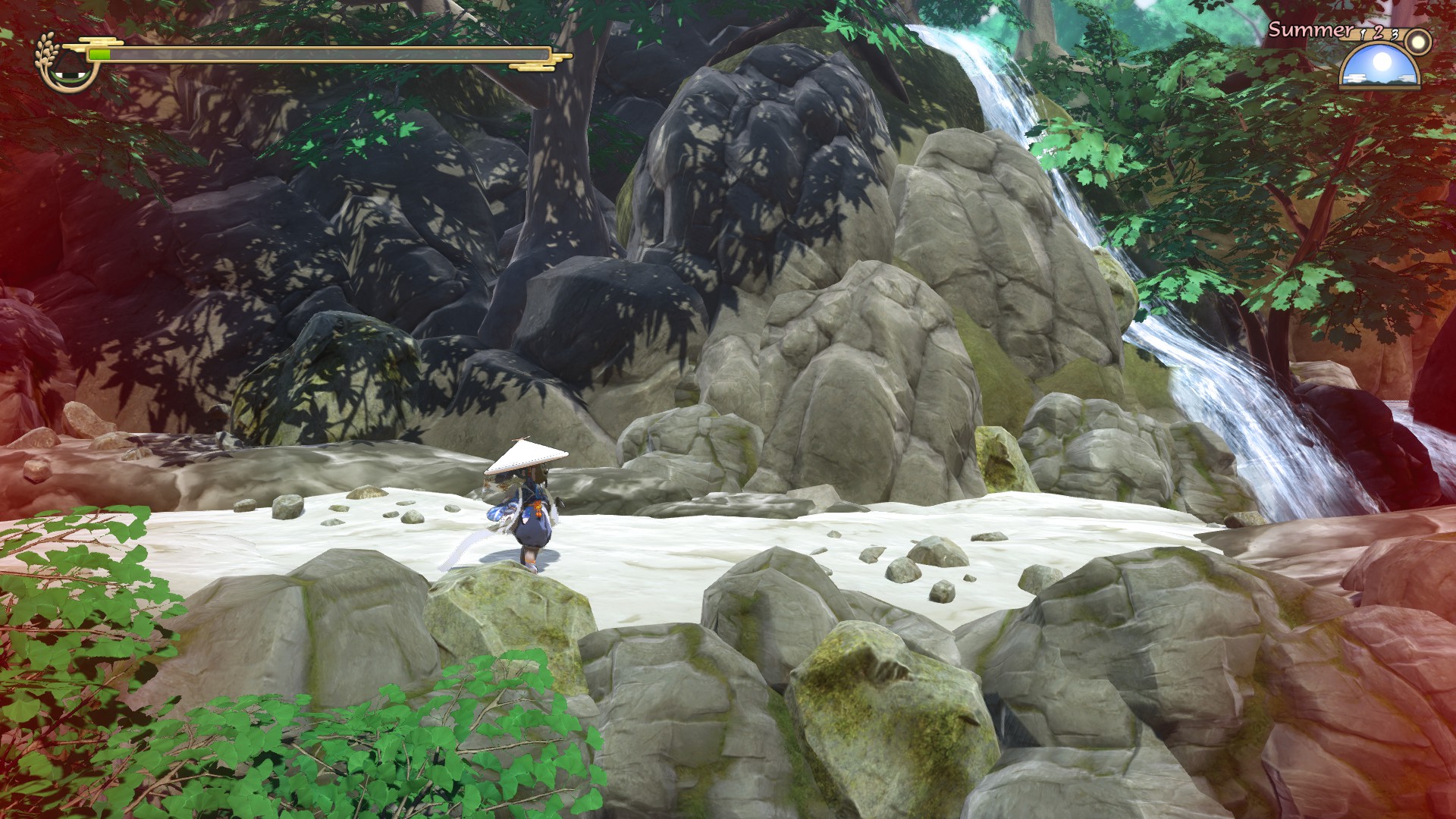
Basic Gameplay
I’ve mentioned Sakuna to have two components – combat and farming – but how, exactly, do they fit together?
As Sakuna, you’re an exiled goddess tasked with clearing the demons dominating the island. The world map contains dozens of short levels. Most of them start inaccessible, opening up as you progress through the story or complete optional objectives in each level, increasing your “exploration level”.
The levels are structured as a platformer, with small “gauntlets” of 2-4 waves of enemies. Some of the levels are very linear, while others have lots of hidden paths and items for you to find. Optional objectives may include killing enemies with specific attacks, finding certain items, clearing them within a certain time, or killing enemies at night – during which they are substantially stronger.
You will also collect a variety of materials and ingredients which you can use for crafting, eating, or fertilizing the soil. Levels are designed to be replayed several times, sometimes for objectives, sometimes for materials. It’s never a “grind”, however.
To tackle stronger enemies, you will need to build your level and stats through farming, also securing the land and clearing it of demons. Typically, you do this in the evening, after a day’s fighting.
Farming is deeply involved with the seasons, too. There are 4 seasons, each with 3 days. You typically till the earth and plant the rice in late winter, and harvest in the summer or autumn. You’ll have to thresh and pound the rice after harvesting, as well as paying attention to the soil’s fertility and pests that may hinder your crops.
Besides the farming, there is also the crafting, which is tied to your companions in the house. Crafting uses materials you get from the levels to create weapons and equipment.
Finally, there’s eating. Food gives you a variety of bonuses, depending on the recipes and ingredients. You have a “fullness” meter, which slowly decreases during the day. At the end of the day, you should process ingredients, choose the menu (for the following day’s bonuses) and have a nice family discussion during meal time!
One thing I’ve got to say is that the whole loop is very compelling. It gives a strong feeling of “just one more day”, especially as you want to take care of all the crafting and cooking with your newly acquired materials, and then want to take care of the fighting after carefully choosing which stat bonuses will be most useful. There’s constant planning between the two main components of the game which makes it a lot more compelling, for me.
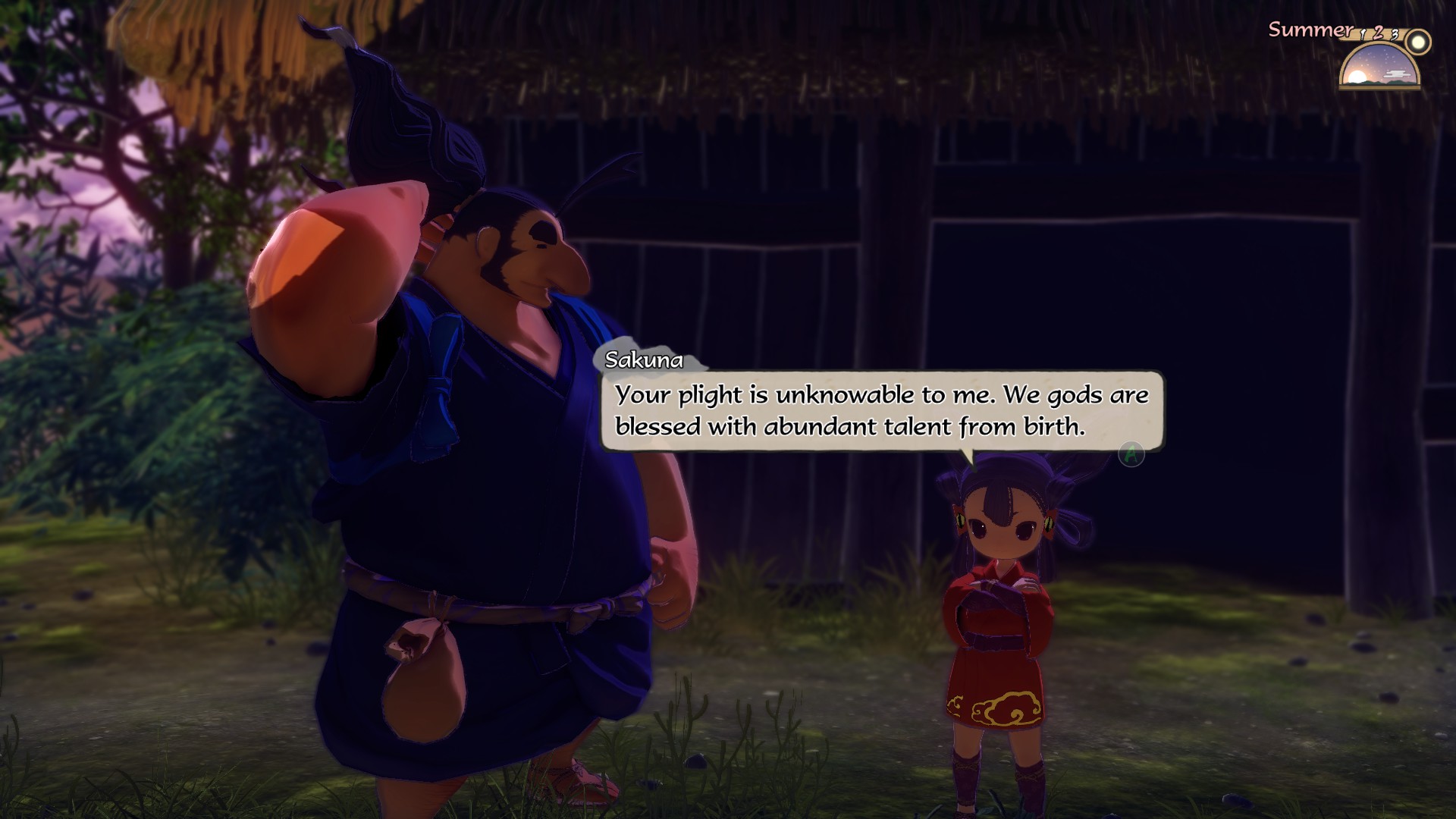
Combat – Gameplay
The review would become too tedious to go into full details about the combat, so I’ll try to keep it short.
You have a quick attack, a heavy attack, special attack, and a “garment” attack. Your garment is basically a grappling hook (most useful for dodging, as it makes you invulnerable). You can chain these together as you would in any spectacle fighter. The combat is very tight and feels great! Attacks are directional, so you can perform a variety of juggling combos.
The most important (and perhaps unbalanced) aspect is “crashing” combos. Basically, certain attacks (one special attack in particular) can send your opponents flying, if you’ve broken their “poise”. When an enemy hits another, it breaks its poise, sends it flying, and does a ton of damage.
Since you most often fight large groups of enemies, this will be the most important tool in your toolbox.
Attacks come in 4 types: Slash, Strike, Pierce, and Magic (there’s also “null”, but I’m not sure what this does as I acquired it only in the endgame). Different enemies may have higher or lower resistances to each type. There are also Fire/Water/Poison modifiers. These are actually interesting, since they interact with the crafting system. Weapons are all “unique” (not built out of components), and while they follow a general power hierarchy, the damage type may be more important than the absolute stat.
There are also “gems” you can slot into equipment and weapons (depending on the piece in particular) that modify the weapon type or other stats.
One particular piece of equipment, a mask, gave me double damage for crashing attacks, but lowered all other damage by 30%. This was my base setup for the whole game, once I got it, and I found it a bit unbalanced. Certain fights, however, didn’t provide you with enough fodder, so mastering the other elements is still important.
Finally, you can also dodge (though I found this rather redundant, given the garment) and parry. Parry is extremely important for 1-on-1 fights with particularly big enemies.
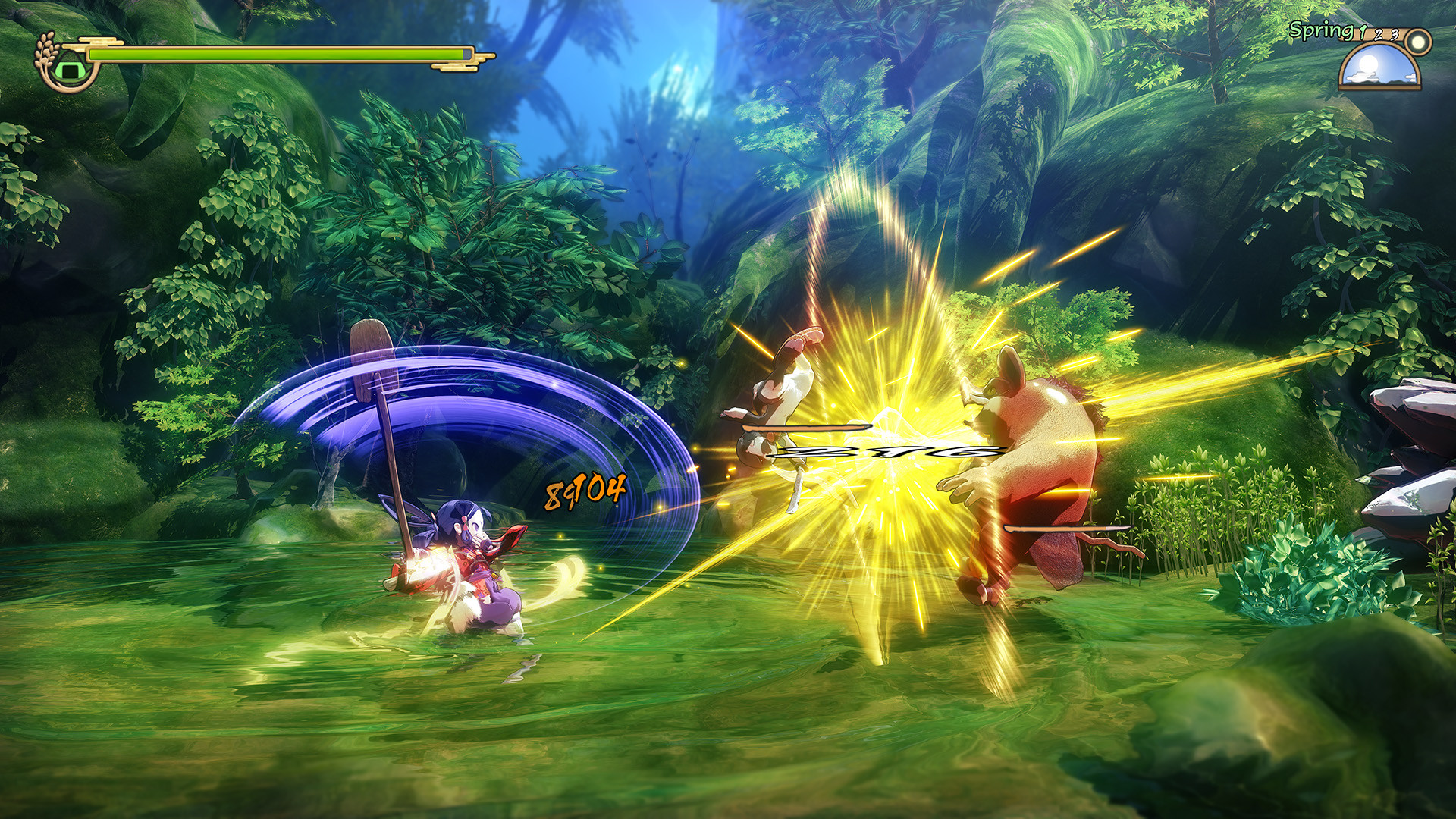
Combat – Difficulty
The game, as I said, is very long. In 40 hours, you will experience some easier and some harder moments. The second half of the game was easier, for the most part, with one exception. The first half was very important, however. The game is demanding – and this is great!
It’s a particular kind of difficult. It doesn’t require you to grind or anything, but it presents you with a completely different challenge, one for which you need new “tools”. By “tools” I mean equipment synergies, or simply a change of tactics.
The game has fairly good enemy variety, but not sustained throughout. You’ll see most of the enemy types in the first half (and they’re reused throughout the second half), but these first encounters are important. You’ll have to think outside the box, sometimes learning to parry, sometimes changing stat modifiers, and so on.
Once you’ve figured it out, however, you can feel the progress. I love it when it takes me twenty to thirty minutes to beat a certain fight, but takes only a minute or two to repeat the feat!
Later on, things get easier, though some boss fights still provide a welcome challenge.
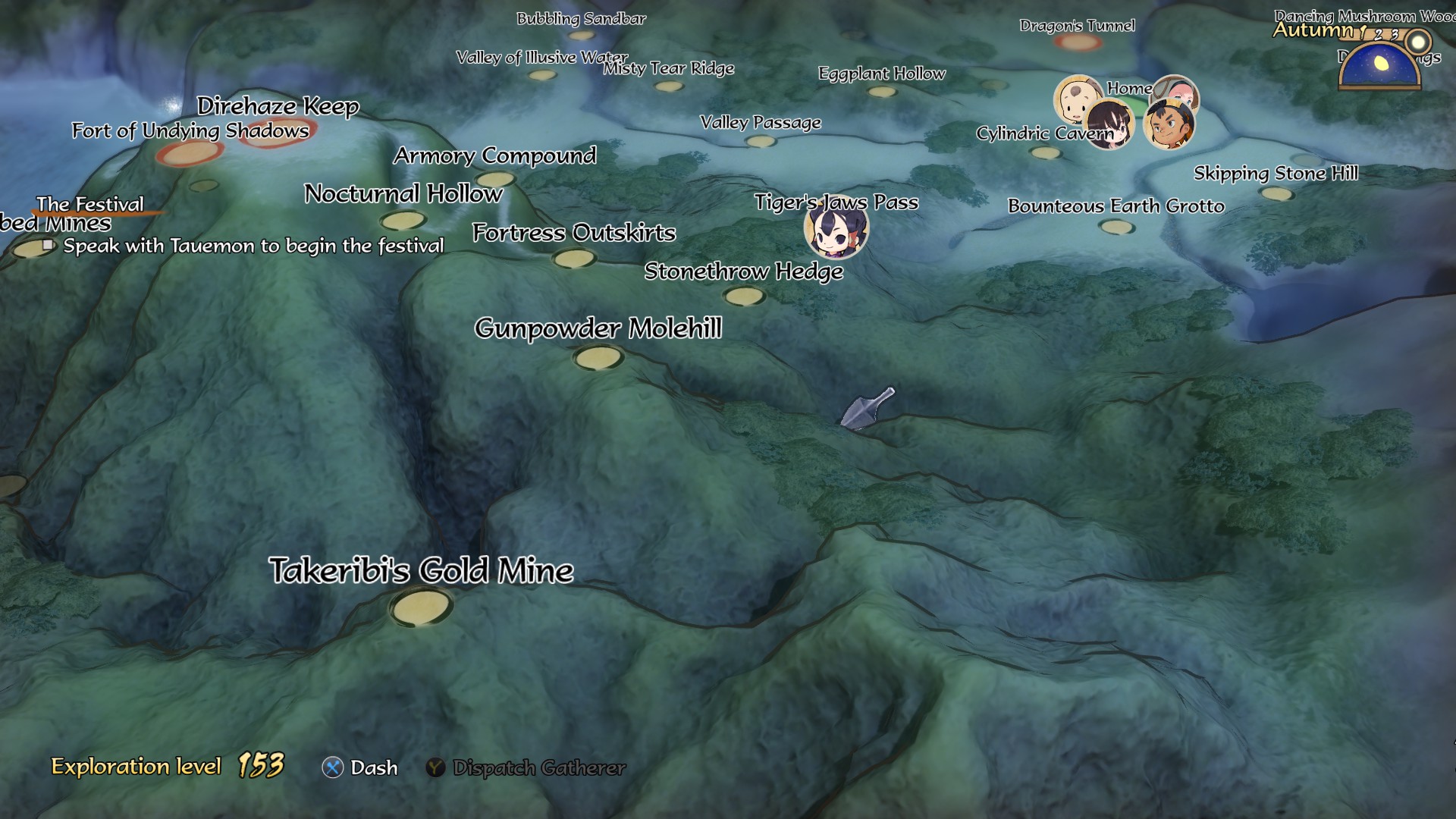
Farming
Farming has a variety of tasks throughout the days and seasons. You do everything from separating good from bad rice, letting it sprout indoors before planting, tilling the earth, planting, removing weeds, fertilizing the soil, harvesting, drying the rice, threshing it, and hulling it. These are are “menial” tasks. It’s labor. Some of them are minigames where you press a button or two rhythmically (threshing and hulling). Tilling the earth is more about pounding the whole earth enough times in small patches to cover your entire plot. Planting is similar, by placing the seeds 1 by 1 (initially) and trying to keep their distance “just right”.
These can be quite lengthy and tedious. But it feels right. After all, farming includes labor. And, even though the tasks may feel a bit long at times, you don’t actually spend long doing them, overall. It’s more of a perception thing, as they’re spread throughout the days and seasons between the normal gameplay.
You will also gain skills to accelerate the process and your companions will build better tools.
The interesting, and somewhat imperfect, aspect of farming is the min-maxing. Your rice controls your character progression, since your level is increased only after the harvests. The soil nutrients will also determine which the stat distribution (you create fertilizer with materials dropped during levels). This is cool!
The trouble comes in the subtler aspects. You’ll find “farming scrolls”, which describe different ways of farming. These are apparently about different configurations of farming. Like placing rice closer together, giving it lots of water in spring but no water at all in midsummer, and so on.
I really like the *idea* of it, but it’s very difficult to use “at the moment” – by which I mean as an isolated reviewer playing a game that isn’t out. There isn’t any information about it.
There are many unclear aspects about the farming that isn’t really explained in the scrolls. Plus, given how distributed over time the several stages are, I found it extremely difficult to judge the influence of each aspect on the harvest. Mostly, I just managed the fertilizer and hoped for the best.
This is a very “Japanese” thing – it reminds me of Pokemon with its IVs and EVs and how you would breed the same pokemon over and over to get the best “nature” and stats, and then proceed to train it by killing only one enemy type, and so on. I love that the system exists and lets you go deep into the optimization, but it is hopelessly opaque before a community is created around the game to clear information.
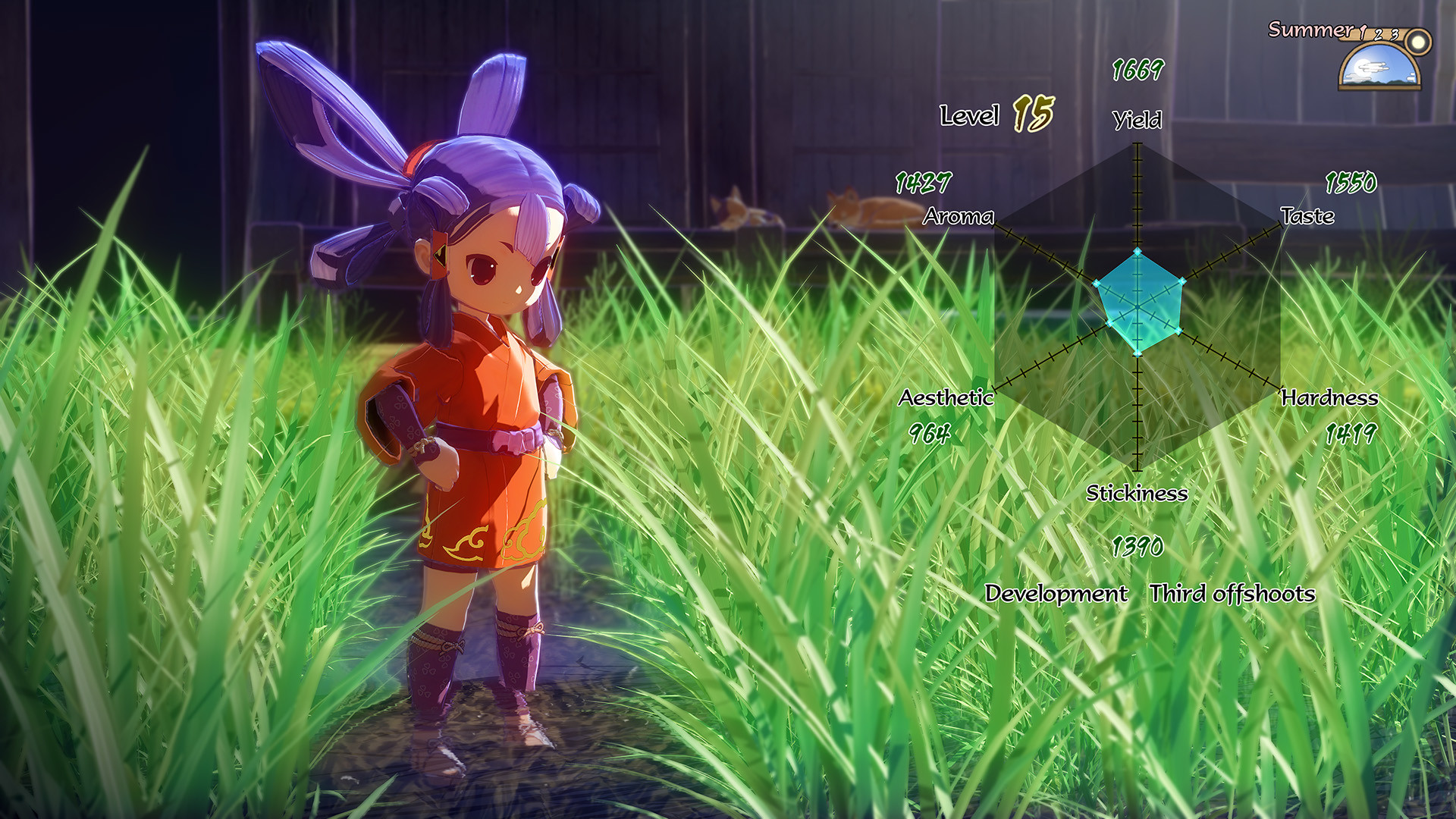
Stuff – and Mindful Gameplay
To conclude, let me talk about “stuff”. I hate “stuff”. By which I mean – pointless and underdesigned systems added to games, or meaningless side quests. I’m mostly talking about, say, The Witcher 3. There is a lot to like in that game, but I find it terrible how the “loop” is: open the map, plot a rough course throughout nearby icons, and collect a piece of random loot or kill a random group of enemies in each. The crafting and alchemy systems were roughly the same. There was no agency there, as you mostly gathered ingredients and recipes by “following the icons” as you do everything in that game.
This is a general “trend” in games in the last decade. Games become extremely bloated in pointless content. It’s the same with Shadow of Mordor, Assassin’s Creed, Infamous, Arkham, etc…
This is different, though. I’ll mention Pokemon again – I love its “stuff”. The existence of legendary and unique pokemon, the deep stat system, the endgame Battle Tower. Sakuna’s stuff is more like this. For example, there’s a 100-level dungeon that’s entirely optional.
In fact, levels 60-100 are locked until you beat the main game.
There is also the crafting system and the food system. These are all akin, in my mind. In particular, because some materials are actually quite rare and are dropped only in specific levels. But it’s not a mindless grind, either, because there are gems and special piece of equipment that increase drop rates.
So all of the extra “stuff” maintains your interest and, most important, *agency*. The various systems are well-designed and thought was put into them. They provide interesting decisions depending on what you want to pursue and let your adapt your playstyle to a high degree.
I’ll say it again – even though the game is 40 hours long, I was excited to play it during the whole time. This is *extremely* rare, for me. I find most long games to become very repetitive and predictable after 15-20 hours. This is not so.
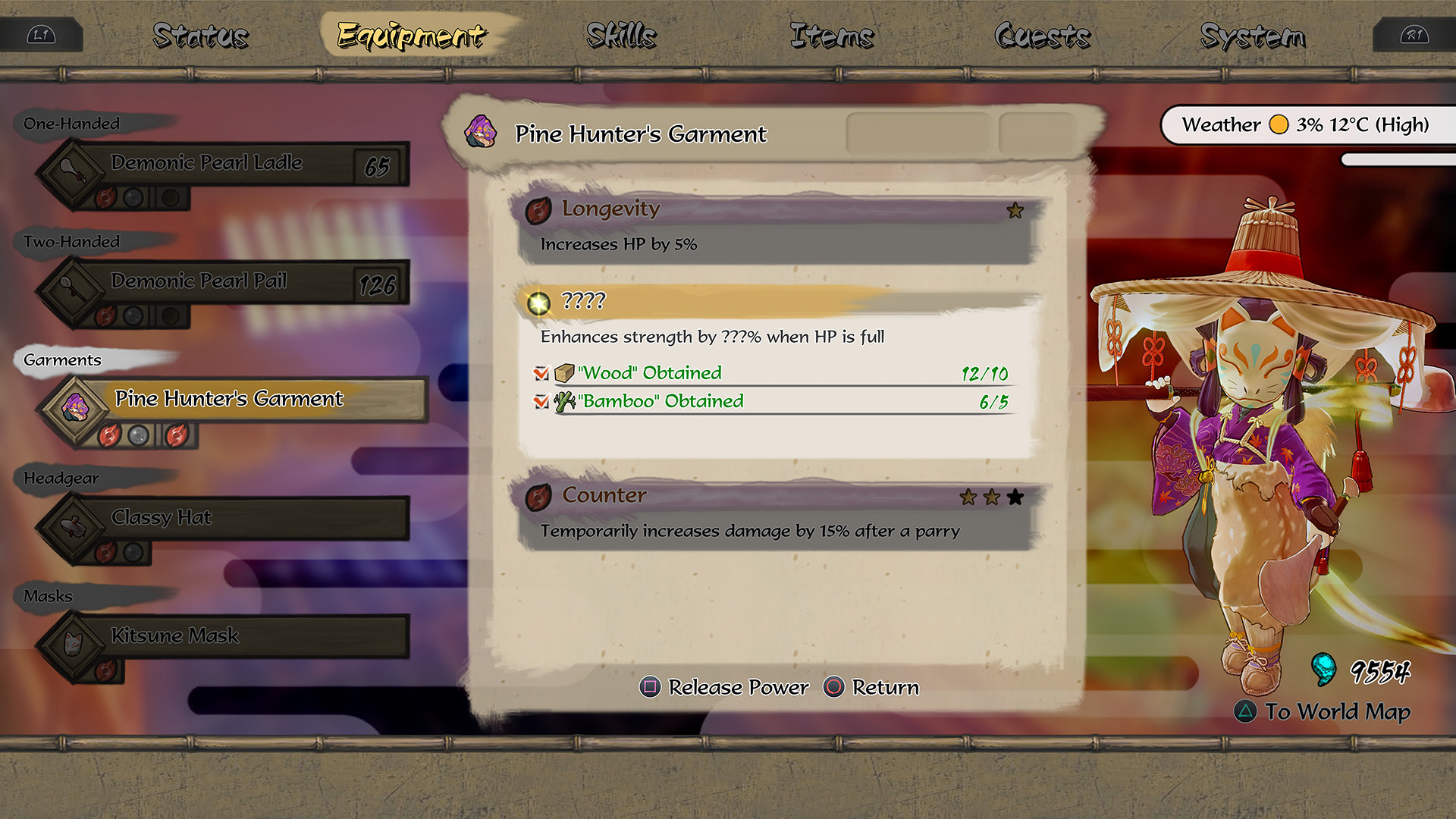
Story and Writing
Ok, to conclude this review. I don’t want to spoil the story, but it was actually very good, much better than most other games, so it deserves at least a mention.
Sakuna, a Goddess, ends up exiled and living with a group of “stray” humans. These come from a variety of backgrounds and have very different skills and views of the world. To a large extent, this is a game about toleration and finding common ground.
This is reflected not just in the main plotline, but also the various sidequests and the short conversations during meal times. It can be a bit too “meek” at times, but I’ve liked it a lot regardless.
There are many beautiful scenes that will not be sullied by knowing the general theme!
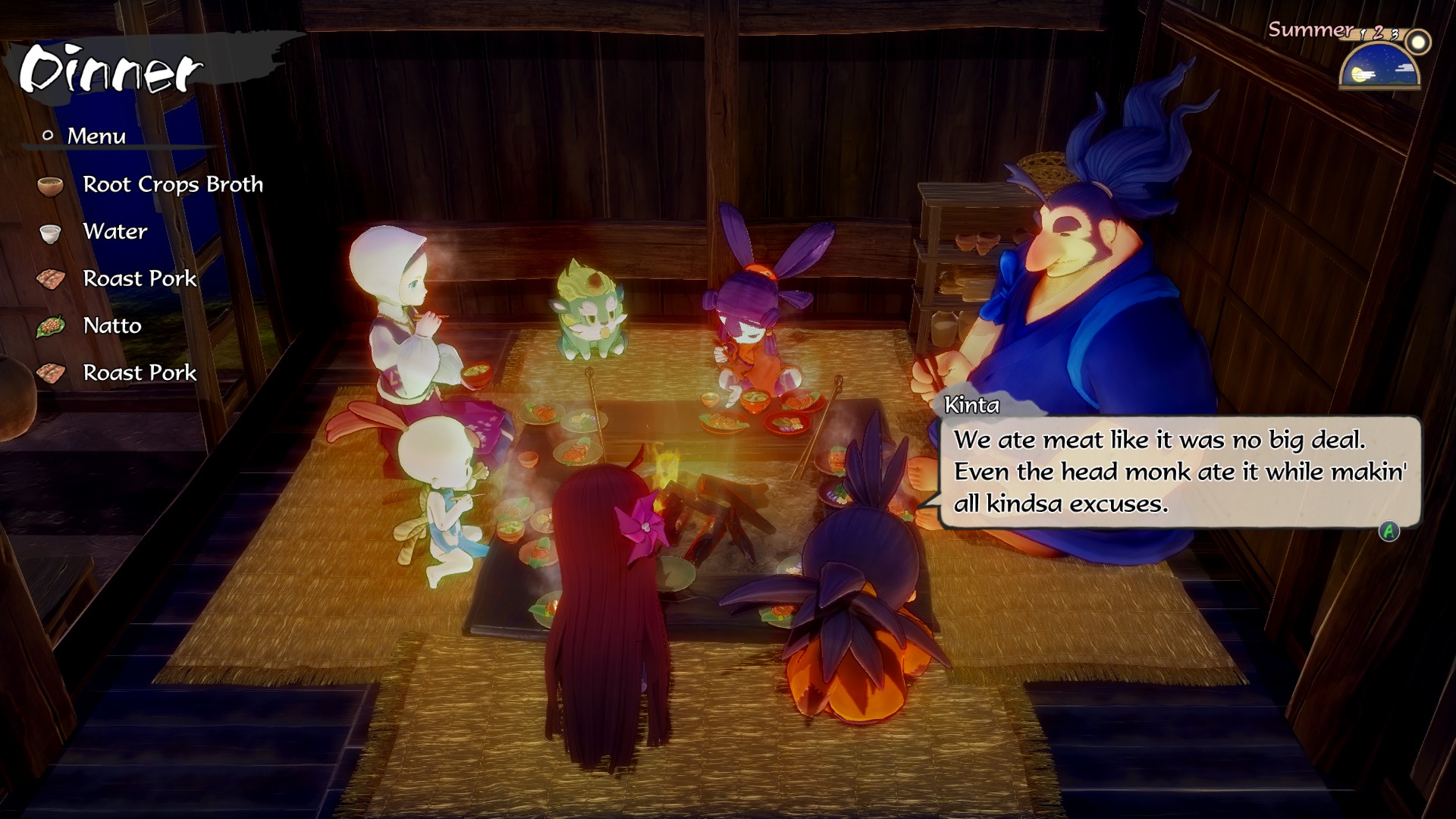
Conclusion
I could probably say a lot more about the game, but this should give you a decent idea.
This game was a very pleasant surprise. Beyond the opaque farming system, I don’t have much to complain about (which should be VERY surprising if you’ve read some of my other reviews haha!), on the contrary.
The game has very tight gameplay and interesting supporting systems. And all of this is topped off by great attention to detail in the visual style and the writing.
I can’t recommend this enough, if you enjoy spectacle fighters and brawlers! I find the surrounding content to be very interesting, but I doubt it would “carry” the game if you have a strong dislike for brawlers.
Edelweiss have managed to create a unique and brilliant game. Definitely get Sakuna: Of Rice and Ruin if you enjoy the genre!

